Ocean
The Living Force
Armenians Mark 100 Years Today Since Genocide Committed by Ottoman Turks
http://www.dailymail.co.uk/news/article-3052102/Harrowing-photo-collection-shows-world-true-horror-Armenian-genocide.html
By Tim Macfarlan For Mailonline
24 April 2015
Revealed: Harrowing photo collection smuggled out of Armenia a century ago by American and colleague who risked imprisonment to show world the true horror of the 'genocide'
John Elder and Armin Wegner both documented the unimaginable suffering they witnessed through horror pictures
Wegner used secret mail routes to sneak images out but was caught by German police and sent to cholera ward
Helped build case against Turkish government which still denies killing of up to 1.5million Armenians was genocide
As world marks 100 years since the atrocities many Western governments including the US still do not use
This is a shocking collection of harrowing photographs of the death and destruction reaped on Armenians by Ottoman Turks a century ago that were taken by an American and a colleague who risked imprisonment to smuggle them out and show the world the full horror of what happened.
John Elder and Armin T. Wegner both documented the unimaginable suffering they witnessed in images which helped build a case against a Turkish government which still denies the slaughter of up to 1.5million Armenians constituted genocide.
As Armenians mark 100 years since the atrocities, many Western countries still do not use that word, and US president Barack Obama is once again unlikely to do so in his upcoming statement marking the anniversary despite pledging he would during his election campaign.
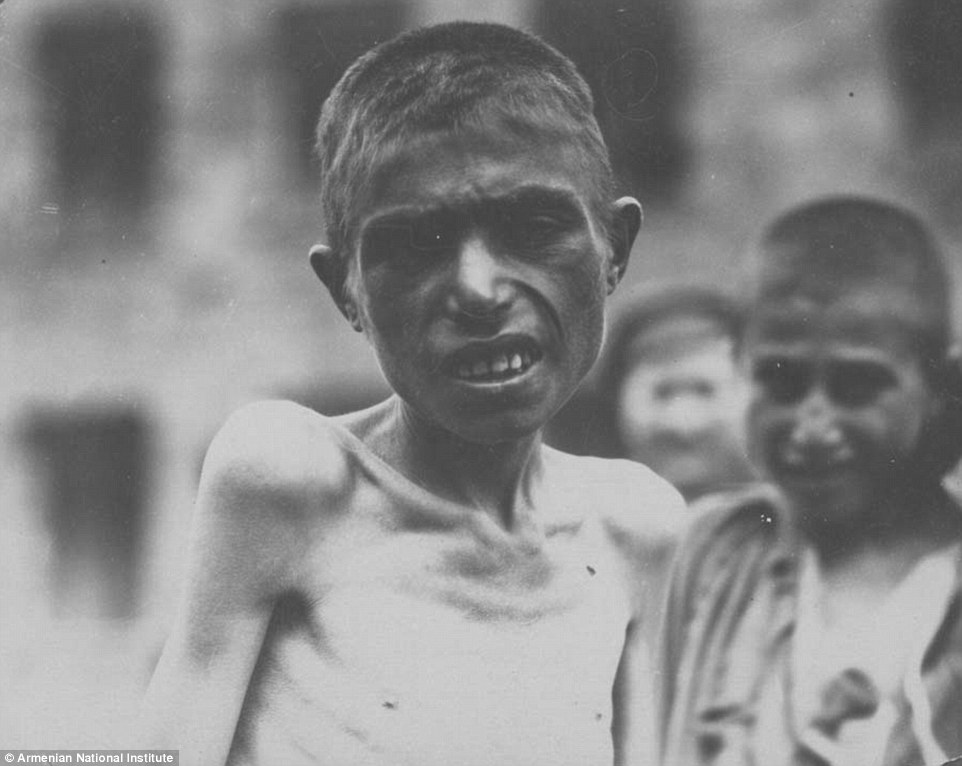
An image of a starving Armenian orphan taken by John Elder. More than 150,000 Armenian children were left parentless by the end of 1918
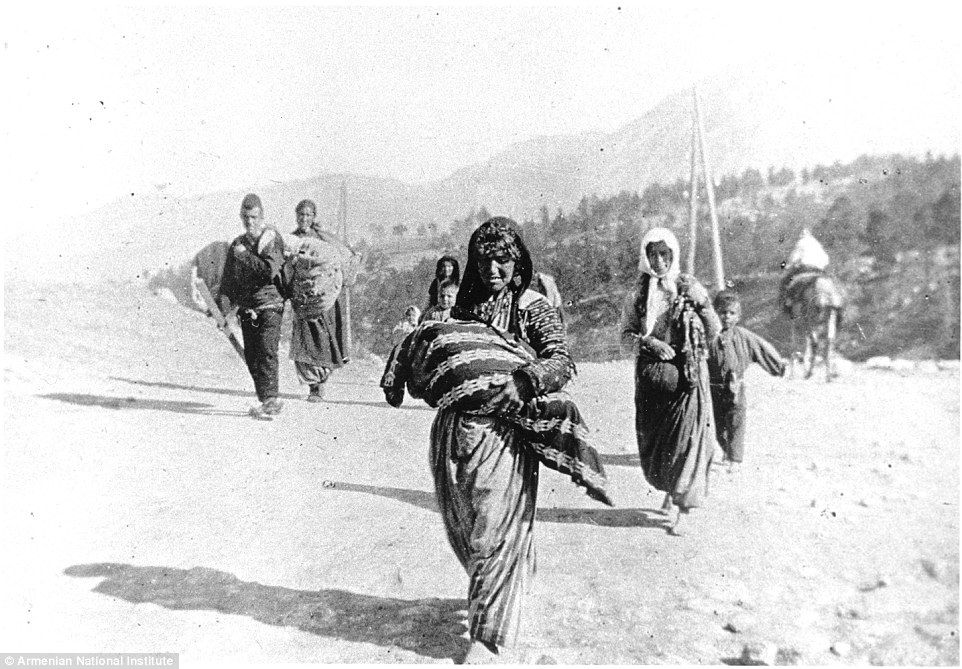
Armenian deportees travel on foot in 1915 as taken by Armin Wegner, including women and children on an unpaved road in the desert sun
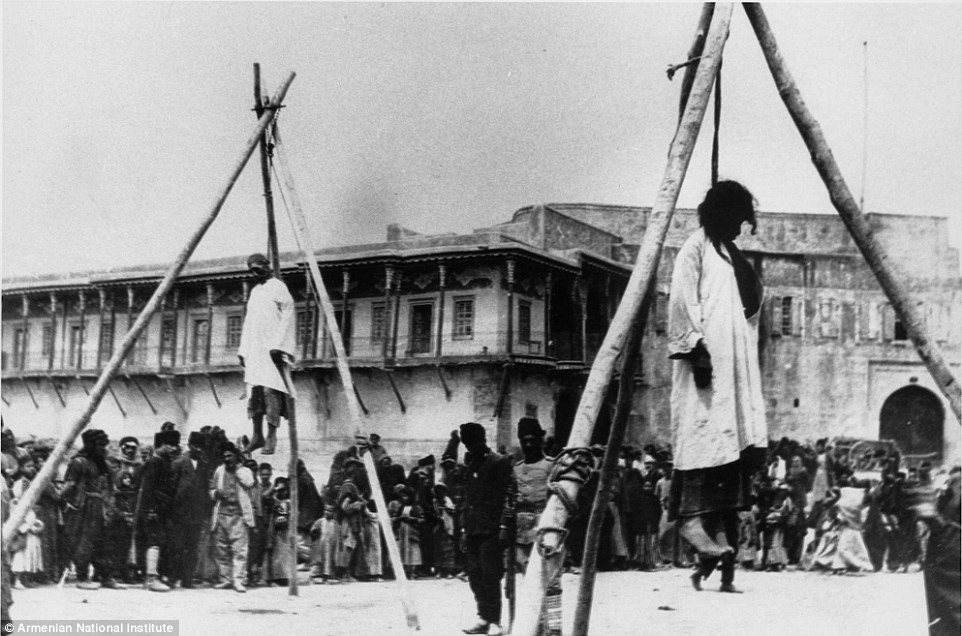
A crowd looks on as Armenians are hanged in the street in Constantinople before their forced removal to the desert had begun after April 1915
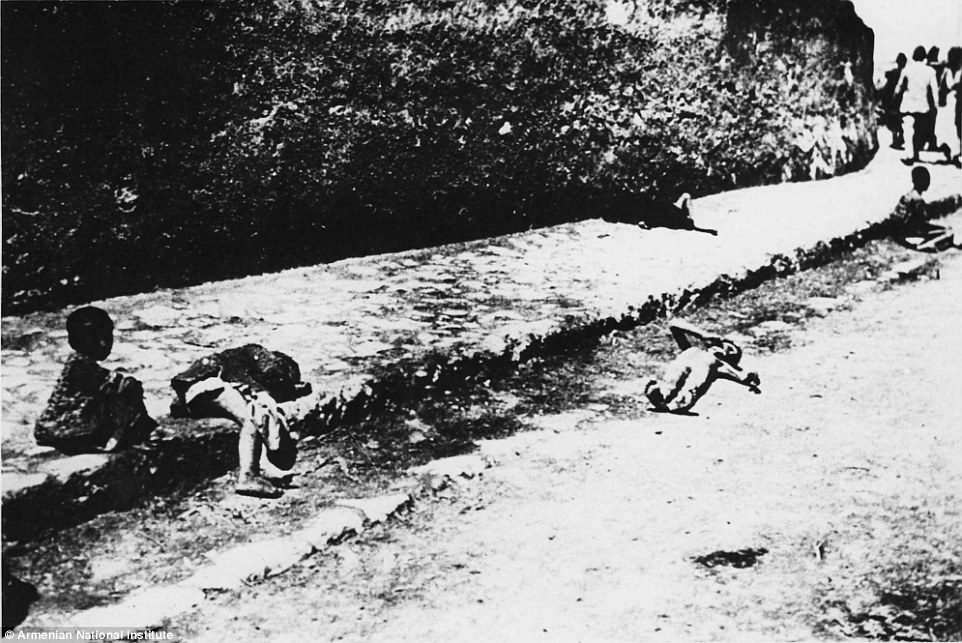
This image was titled 'Abandoned and murdered small children of the (Armenian) deportees' by Wegner and was taken in 1915-1916
Wegner, a volunteer military nurse, set up clandestine mail routes with foreign consulates and embassies to get many hundreds of notes, annotations, documents, letters and photographs of the Armenian deportation camps to Germany and the United States.
He did so in defiance of strict orders from the Turkish and German authorities aimed at preventing any evidence of the horrors of the 'genocide' reaching the outside world.
But his ruse was discovered and he was arrested by the German authorities and put to serve in cholera wards in Baghdad at the request of the Turkish command.
There he fell seriously ill, and German-born Wegner left for Constantinople (modern-day Istanbul) in November 1916. Hidden in his belt were his photographic plates, and those of other German officers, with images of the Armenian massacre to which he had been a witness.
His images still retain the power to shock as the world marks the 100th anniversary of the 'genocide' today.
In one, two Armenians are pictured hanging in the street in broad daylight in the capital Constantinople while a crowd, including women and children, looks on.
The image was taken in 1915 just before the mass deportation of Armenians to the desert had begun. Hundreds of thousands were forced from their homes in Anatolia and herded towards Syria.
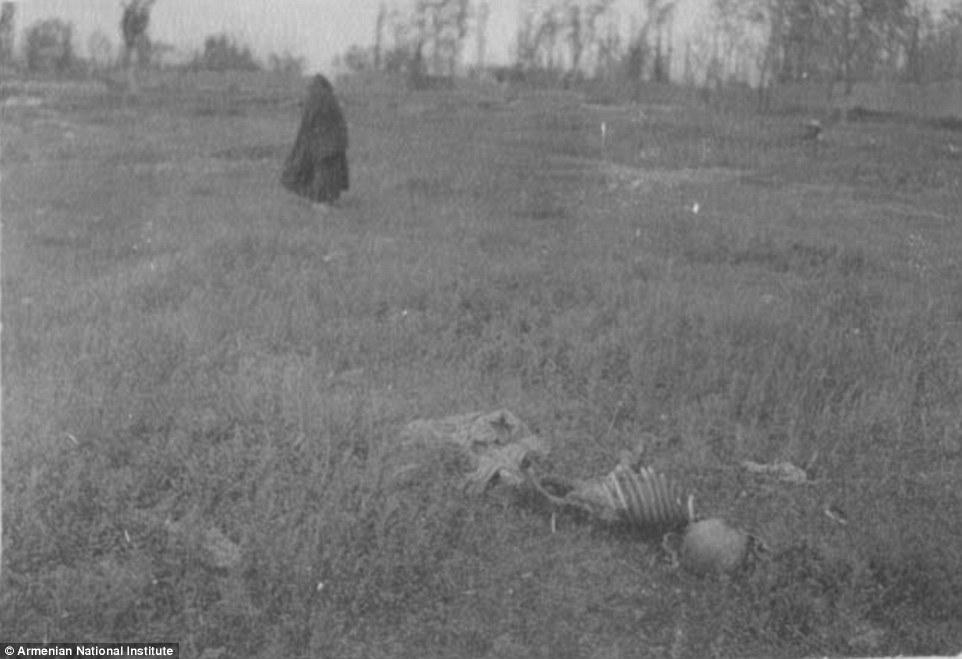
A skeleton is resting in a refugee graveyard while a black clad figure walks away from the camera in Igdir, now in Eastern Anatolia in Turkey
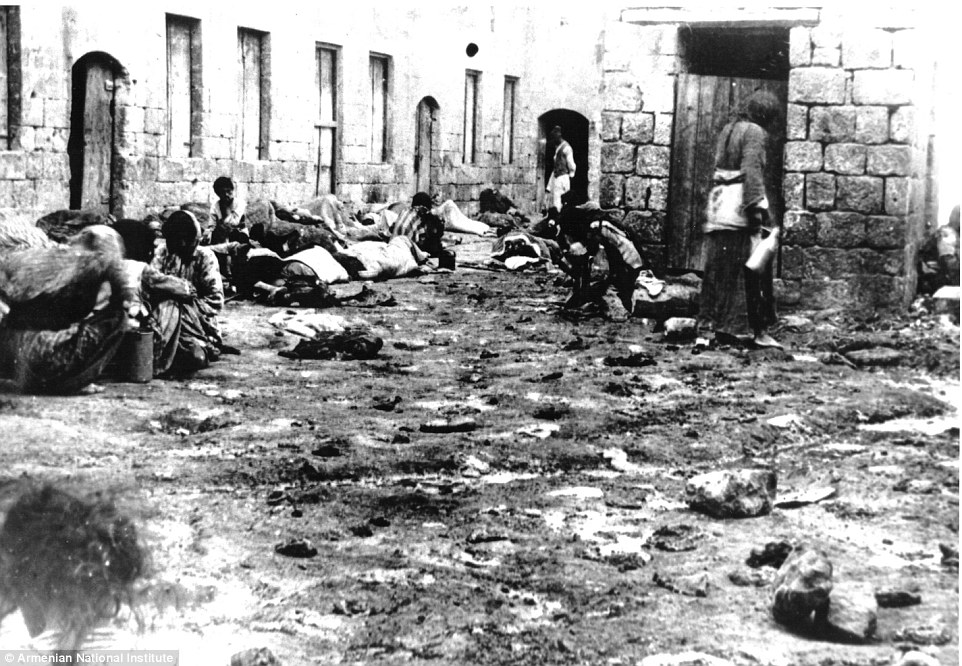
Armenian deportees sleeping in the street in 1915 in the Syrian region of the Ottoman empire. They are mostly women without families
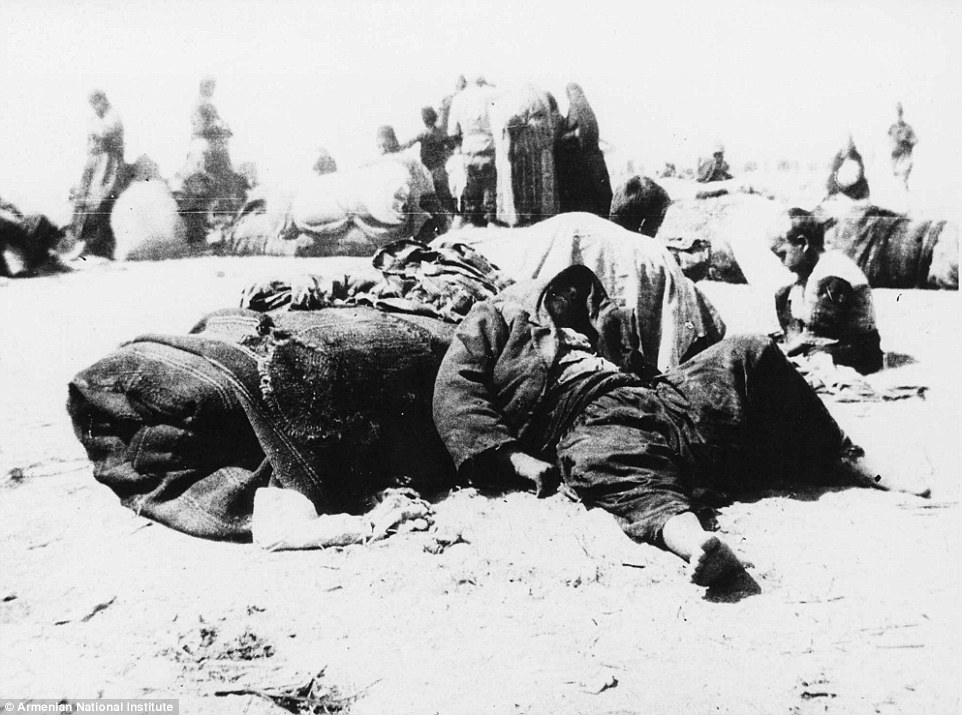
Orphans of the massacre take a rest. Hundreds of thousands of Armenians were forced from their homes in Anatolia and herded towards Syria
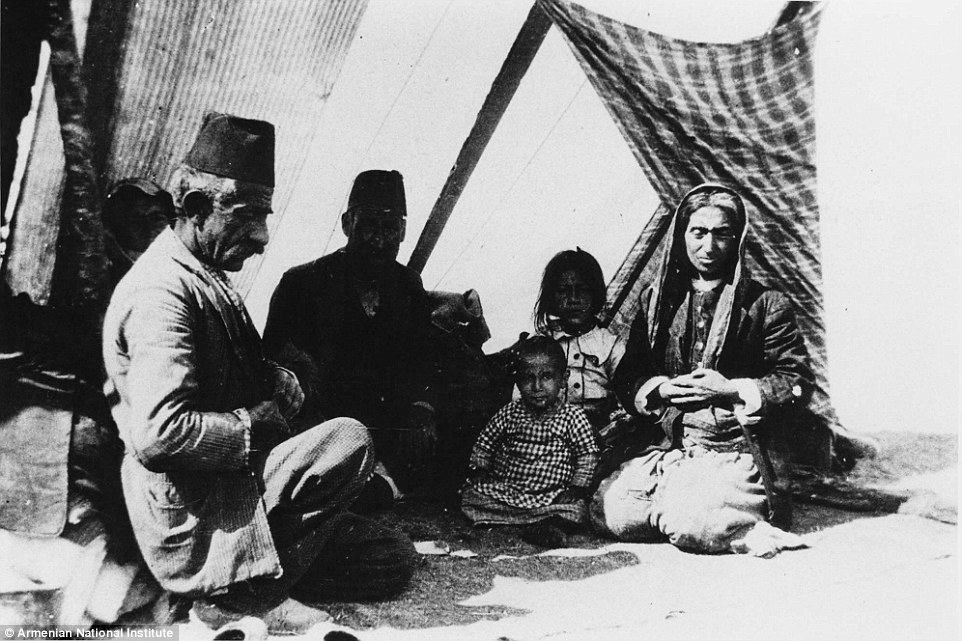
Three generations of the same family of refugees take shelter from the son in a makeshift tent. Many of those targeted for expulsion starved to death, were shot or bayoneted by Ottoman Turkish soldiers
The then two million strong Armenian minority were persecuted by a government suspicious that as Christians they were more loyal to Christian governments like that of Russia than they were to the Ottoman caliphate.
Though they had thrived under Ottoman rule, despite being regarded as 'infidels' by their Muslim rulers, the Armenians were resented for their relative prosperity and success compared to many Ottoman Turks.
The Ottoman government began their campaign in earnest after Armenians organized volunteer battalions to help the Russian army fight against the Turks in the Caucasus region. The Ottoman government used this as a justification to begin their forced 'removal' of Armenians the war zones along the Eastern Front in a bid to 'Turkify' what remained of a ailing empire.
The deportation began following the rounding up of 235 Armenian leaders and intellectuals in the capital on April 24, 1915 - the anniversary of which is marked today. Many of those then targeted for expulsion starved to death, were shot or bayoneted by Ottoman Turkish soldiers.
Another photograph shows the bodies of three murdered young boys lying in a gutter, one of them stripped naked, while two others look on. More than 150,000 Armenian children were left parentless by the end of the First World War.
And in a third of Wegner's incredible images taken in 1915, a band of Armenian deportees, including a woman carrying a baby, children and elderly men, stagger through the desert along an unpaved road in the blazing suns towards their hellish new lives as refugees.
Elder, from Pennsylvania, was a relief worker in the Armenian capital of Yerevan from 1917 to 1919
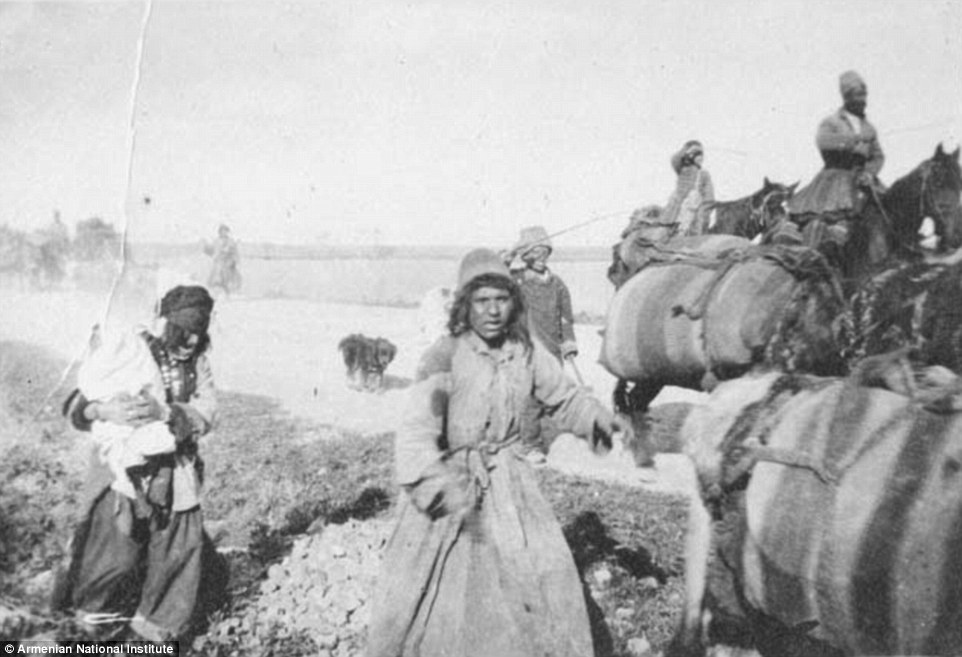
Refugees struggle to make their way along the Igdir road. The city was occupied in 1920 and is now part of a region of eastern Turkey
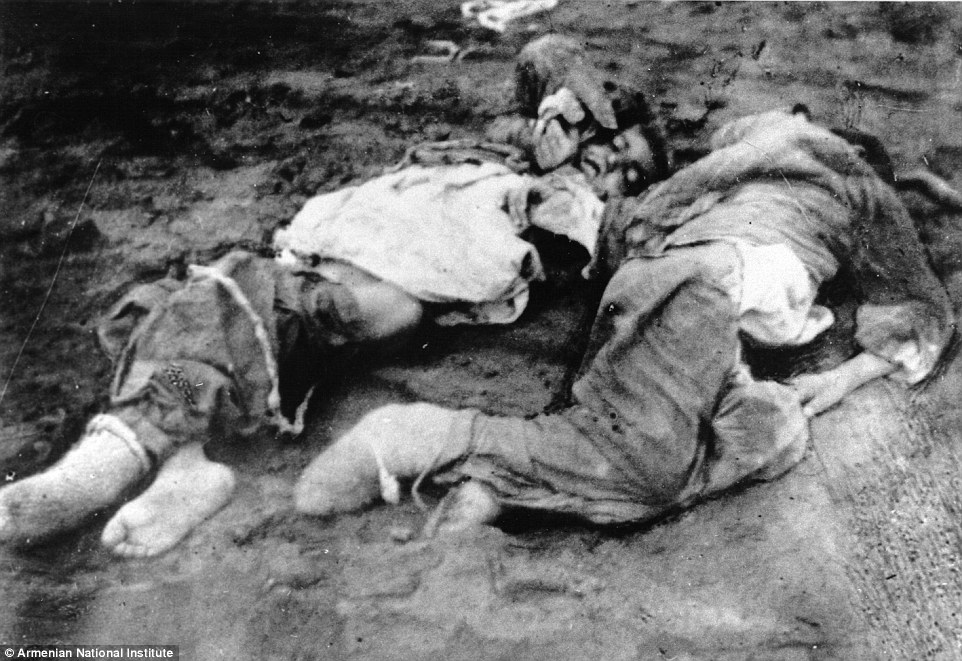
'A 15-year-old child who died of starvation', according to Wegner, who took the image of the two bodies of young boys in 1915-1916
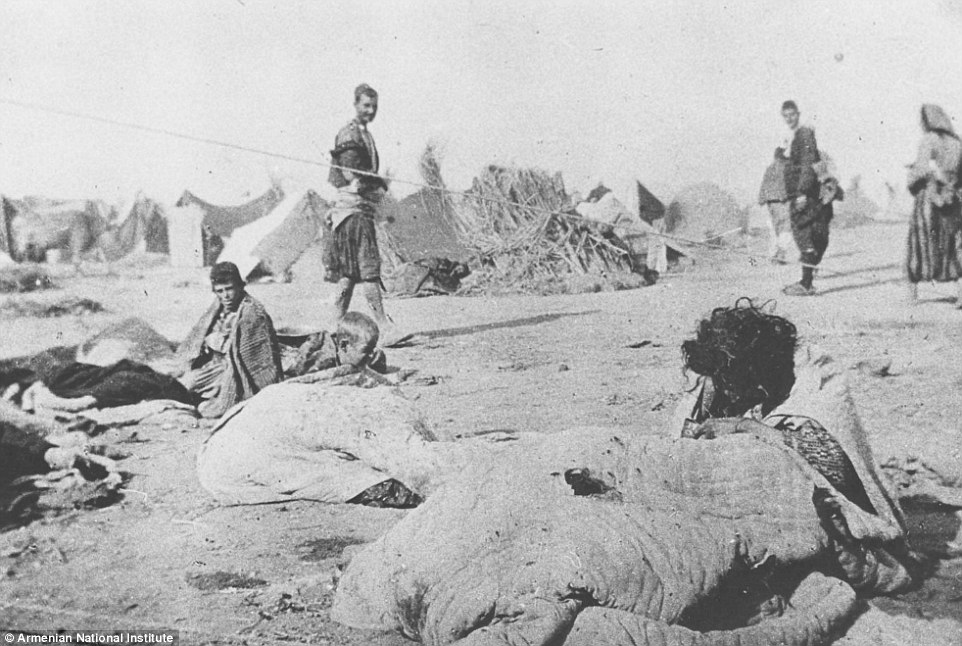
Armenian deportees living in the open desert with bedding as their only shelter, though luckier families in the background have tents
Elder's pictures of orphans are particularly harrowing, some of them clearly starving with angular bones poking through the stretched skin of their shrunken bodies.
In one eerie shot a human skeleton is pictured resting in a refugee graveyard while a black clad figure walks away from the camera in the background. In another refugees desperately forage for food by a railway track.
In light of such evidence Obama's reticence to use the word 'genocide', in a bid to placate America's Turkish allies, has disappointed many.
Several US officials said there had been a sharp internal debate over whether to use the 100-year anniversary to call the killings 'genocide' and make good on the president's campaign promise, particularly after Pope Francis used the term earlier this month.
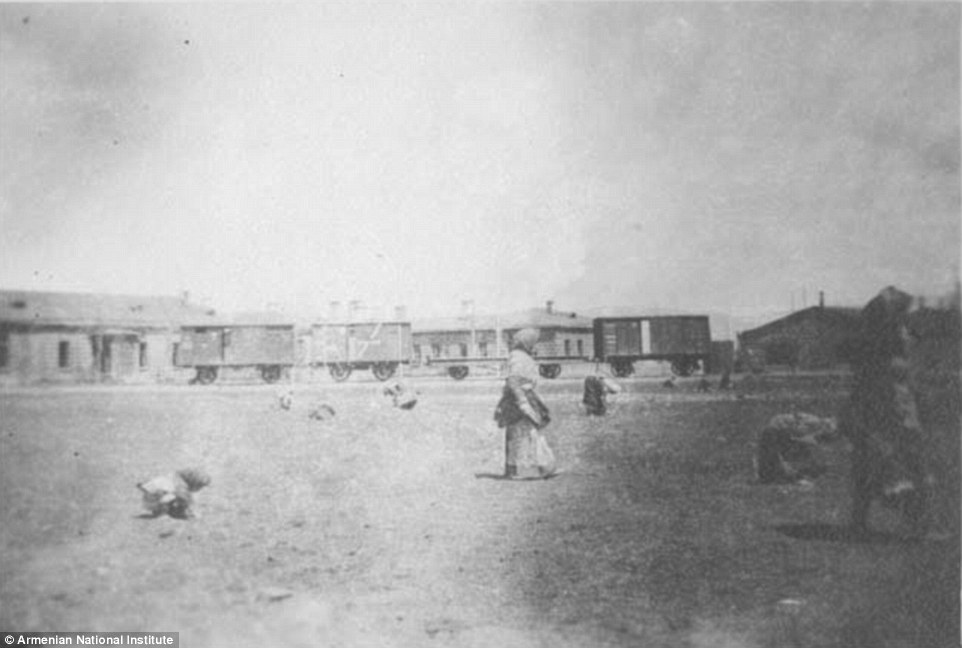
Refugees foraging for food at by a railway track at Alexandropol. The city is now called Gyumri, the second largest in Armenia
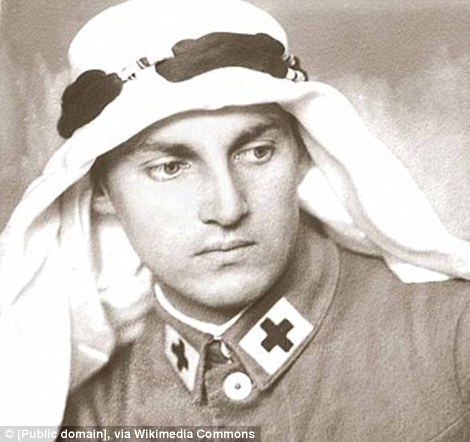
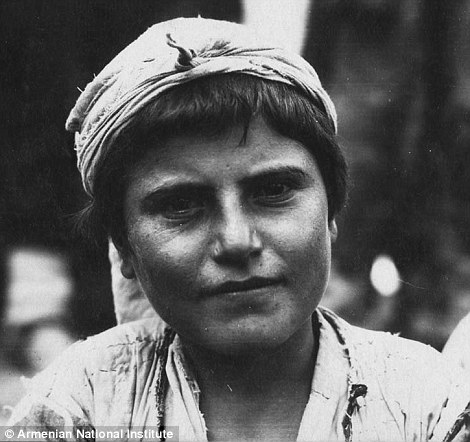
Armin Wegner (left) fearlessly documented the horror with his camera just like Elder, who took this image of an Armenian refugee (right)
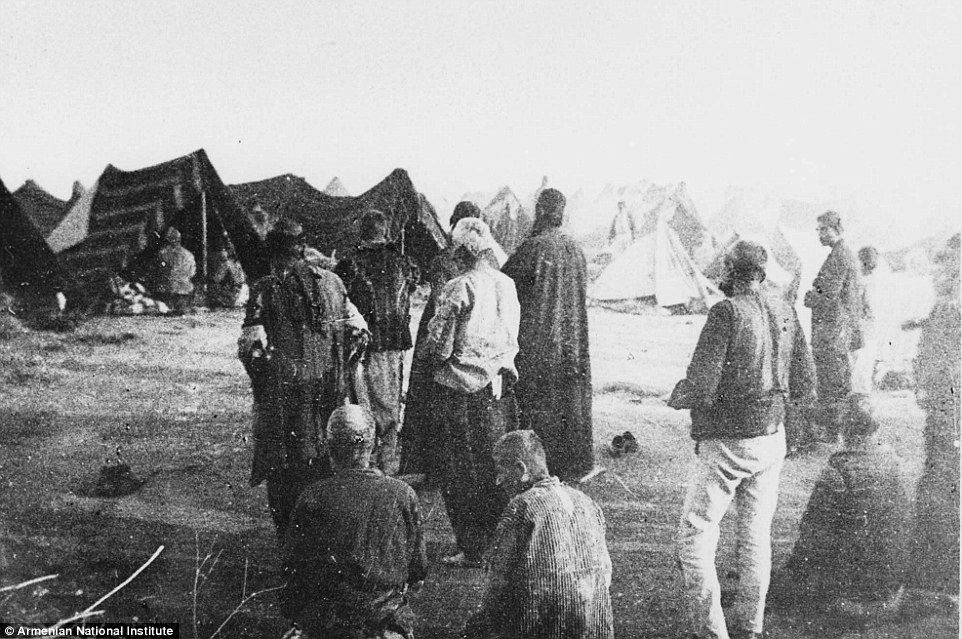
A burial service is held at a deportation camp. Wegner describe the scene as 'Armenian deportees living in the open desert under makeshift tents. Clothing of some deportees is already worn to rags'
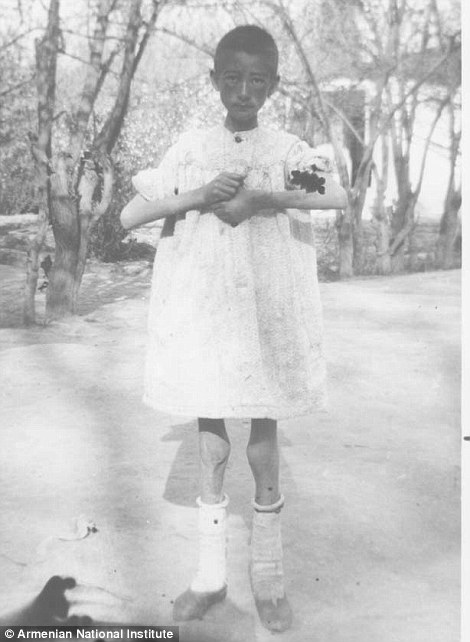
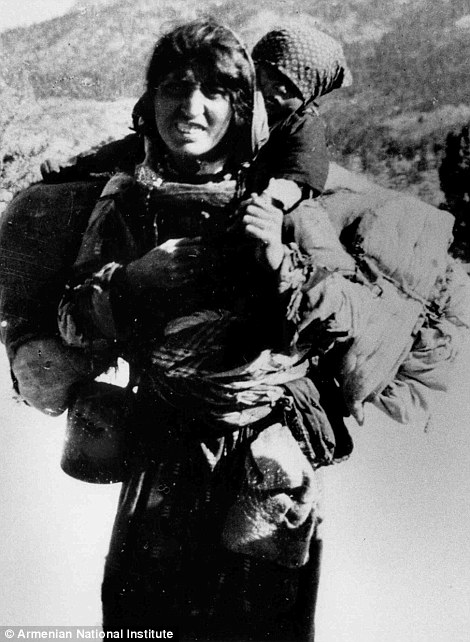
A painfully thin orphan of the massacre (left) taken by Elder in Yerevan, now the capital of Armenia, in 1918. Wegner captioned the image on the right: 'Fleeing from death. An Armenian mother on the heights of the Taurus Mountains whose husband has been killed'
That comment by the Pope prompted an angry response from Turkey, which recalled its ambassador to the Vatican. Several European governments and parliaments are also expected to use the word in discussions of the events 100 years ago.
The number of Armenians who died during this period is in fact only around 300,000, according to Turkey, which still blames 'war and disease' rather than a targeted programme of extermination by the Ottoman government.
Recep Tayyip Erdogan, the Turkish president, said at a press conference on Wednesday he 'would not want Obama to use the word "genocide" and would not expect such a thing.'
The country's prime minister Ahmet Davutoglu accused the European Parliament of 'enmity' against Turkey over its vote to use the term to describe the killings.
In his formal statement on the anniversary he also insisted that Armenian losses were among many in the First World War and that it was a form of 'discrimination' to focus on Armenians and not on 'Turkish and Muslim Ottomans' who died at the same time.
His words did not stop dozens of Armenians from gathering on Wednesday for an annual commemoration ceremony at a chasm at a site called Dudan, near the city of Diyarbakir in southeastern Turkey, where it is believed there is a mass grave to victims of the 'genocide'.
Around 10,000 are thought to have been led here by Turkish military police in 1915 before being brutally murdered and thrown into the cleft in the rock.
At the Tsitsernakaberd Memorial in Yerevan today Russian President Vladimir Putin and French President Francois Hollande joined Armenian Apostolic Church leader Catholicos Garegin II and Serbian President Tomislav Nikolic at the 100th anniversary ceremony remembering the 'genocide'.
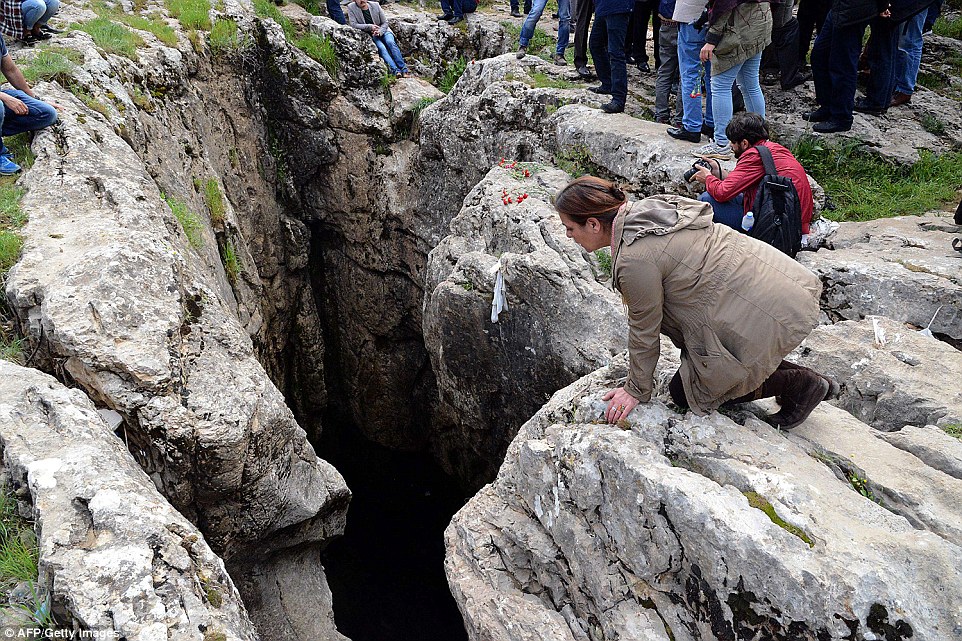
A woman leans to peek into a chasm as Armenian people gather during an anniversary ceremony at a site called Dudan near Diyarbakir, believed to be a mass grave of the 'Armenian Genocide'
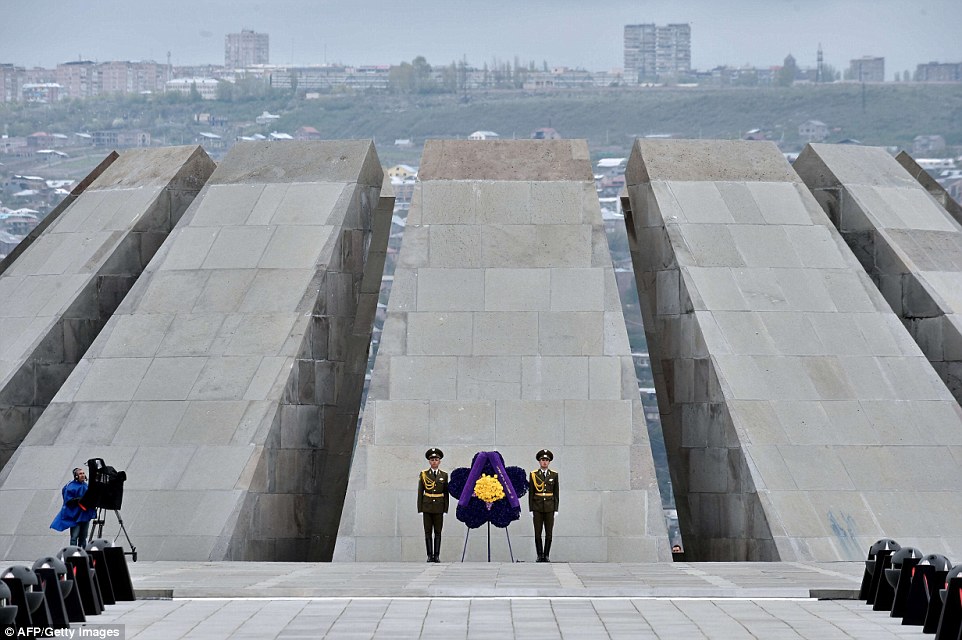
Soldiers stand guard in front of the Tsitsernakaberd Memorial in Yerevan during a commemoration ceremony to mark the 100th anniversary of the Armenian 'genocide' today
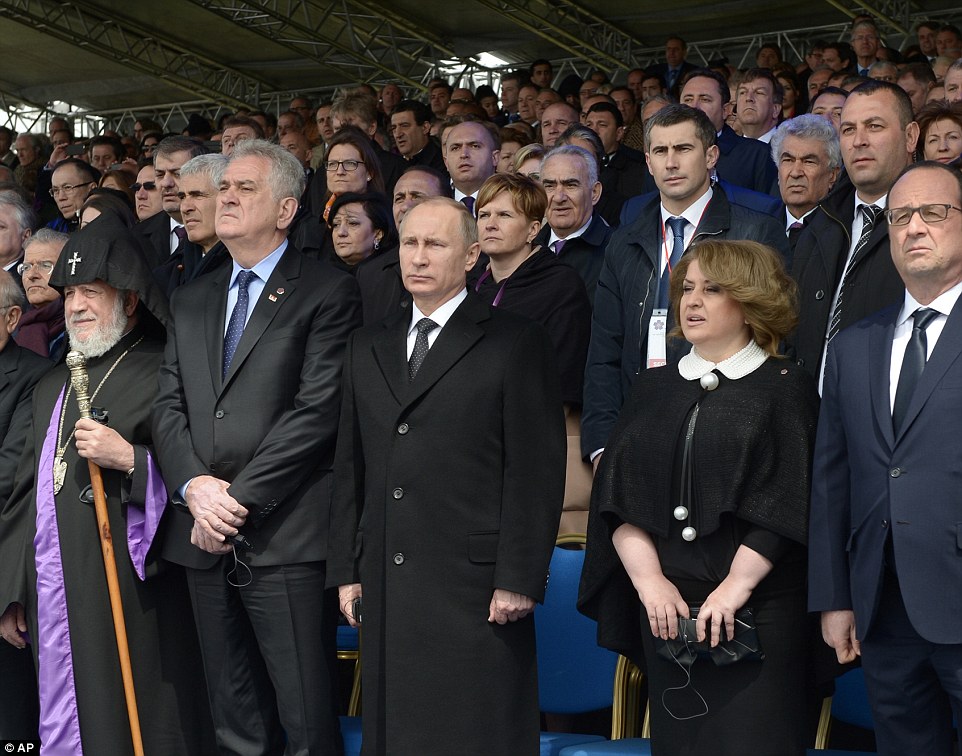
Left to right: Armenian Apostolic Church leader Catholicos Garegin II, Serbian President Tomislav Nikolic, Russian President Vladimir Putin, Rita, the wife of Armenia's President Serge Sarkisian and French President Francois Hollande at the ceremony
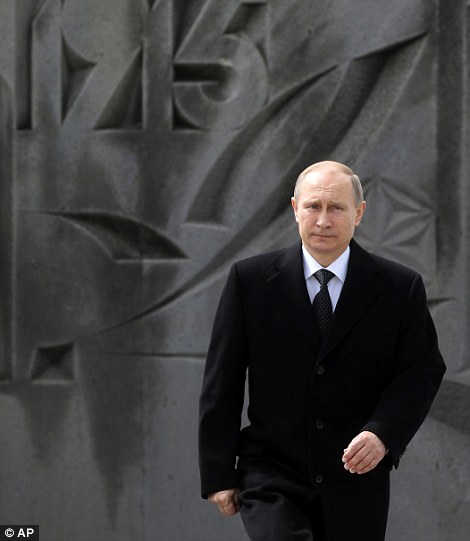
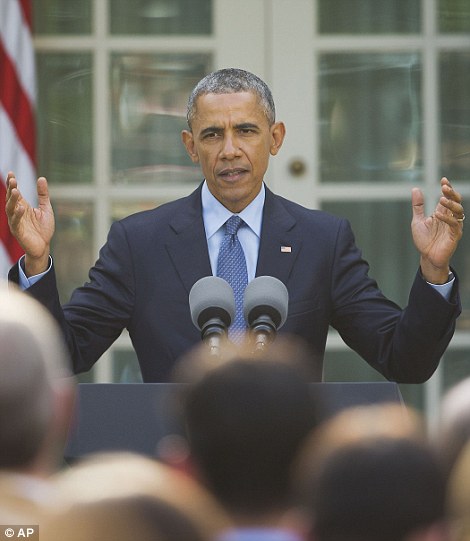
Vladimir Putin at the Armenian Genocide memorial complex today (left). US President Barack Obama (right) continues to avoid using the word 'genocide' in connection with what happened to the Armenians at the hands of the Ottoman Turks
http://www.dailymail.co.uk/news/article-3052102/Harrowing-photo-collection-shows-world-true-horror-Armenian-genocide.html
By Tim Macfarlan For Mailonline
24 April 2015
Revealed: Harrowing photo collection smuggled out of Armenia a century ago by American and colleague who risked imprisonment to show world the true horror of the 'genocide'
John Elder and Armin Wegner both documented the unimaginable suffering they witnessed through horror pictures
Wegner used secret mail routes to sneak images out but was caught by German police and sent to cholera ward
Helped build case against Turkish government which still denies killing of up to 1.5million Armenians was genocide
As world marks 100 years since the atrocities many Western governments including the US still do not use
This is a shocking collection of harrowing photographs of the death and destruction reaped on Armenians by Ottoman Turks a century ago that were taken by an American and a colleague who risked imprisonment to smuggle them out and show the world the full horror of what happened.
John Elder and Armin T. Wegner both documented the unimaginable suffering they witnessed in images which helped build a case against a Turkish government which still denies the slaughter of up to 1.5million Armenians constituted genocide.
As Armenians mark 100 years since the atrocities, many Western countries still do not use that word, and US president Barack Obama is once again unlikely to do so in his upcoming statement marking the anniversary despite pledging he would during his election campaign.

An image of a starving Armenian orphan taken by John Elder. More than 150,000 Armenian children were left parentless by the end of 1918

Armenian deportees travel on foot in 1915 as taken by Armin Wegner, including women and children on an unpaved road in the desert sun

A crowd looks on as Armenians are hanged in the street in Constantinople before their forced removal to the desert had begun after April 1915

This image was titled 'Abandoned and murdered small children of the (Armenian) deportees' by Wegner and was taken in 1915-1916
Wegner, a volunteer military nurse, set up clandestine mail routes with foreign consulates and embassies to get many hundreds of notes, annotations, documents, letters and photographs of the Armenian deportation camps to Germany and the United States.
He did so in defiance of strict orders from the Turkish and German authorities aimed at preventing any evidence of the horrors of the 'genocide' reaching the outside world.
But his ruse was discovered and he was arrested by the German authorities and put to serve in cholera wards in Baghdad at the request of the Turkish command.
There he fell seriously ill, and German-born Wegner left for Constantinople (modern-day Istanbul) in November 1916. Hidden in his belt were his photographic plates, and those of other German officers, with images of the Armenian massacre to which he had been a witness.
His images still retain the power to shock as the world marks the 100th anniversary of the 'genocide' today.
In one, two Armenians are pictured hanging in the street in broad daylight in the capital Constantinople while a crowd, including women and children, looks on.
The image was taken in 1915 just before the mass deportation of Armenians to the desert had begun. Hundreds of thousands were forced from their homes in Anatolia and herded towards Syria.

A skeleton is resting in a refugee graveyard while a black clad figure walks away from the camera in Igdir, now in Eastern Anatolia in Turkey

Armenian deportees sleeping in the street in 1915 in the Syrian region of the Ottoman empire. They are mostly women without families

Orphans of the massacre take a rest. Hundreds of thousands of Armenians were forced from their homes in Anatolia and herded towards Syria

Three generations of the same family of refugees take shelter from the son in a makeshift tent. Many of those targeted for expulsion starved to death, were shot or bayoneted by Ottoman Turkish soldiers
The then two million strong Armenian minority were persecuted by a government suspicious that as Christians they were more loyal to Christian governments like that of Russia than they were to the Ottoman caliphate.
Though they had thrived under Ottoman rule, despite being regarded as 'infidels' by their Muslim rulers, the Armenians were resented for their relative prosperity and success compared to many Ottoman Turks.
The Ottoman government began their campaign in earnest after Armenians organized volunteer battalions to help the Russian army fight against the Turks in the Caucasus region. The Ottoman government used this as a justification to begin their forced 'removal' of Armenians the war zones along the Eastern Front in a bid to 'Turkify' what remained of a ailing empire.
The deportation began following the rounding up of 235 Armenian leaders and intellectuals in the capital on April 24, 1915 - the anniversary of which is marked today. Many of those then targeted for expulsion starved to death, were shot or bayoneted by Ottoman Turkish soldiers.
Another photograph shows the bodies of three murdered young boys lying in a gutter, one of them stripped naked, while two others look on. More than 150,000 Armenian children were left parentless by the end of the First World War.
And in a third of Wegner's incredible images taken in 1915, a band of Armenian deportees, including a woman carrying a baby, children and elderly men, stagger through the desert along an unpaved road in the blazing suns towards their hellish new lives as refugees.
Elder, from Pennsylvania, was a relief worker in the Armenian capital of Yerevan from 1917 to 1919

Refugees struggle to make their way along the Igdir road. The city was occupied in 1920 and is now part of a region of eastern Turkey

'A 15-year-old child who died of starvation', according to Wegner, who took the image of the two bodies of young boys in 1915-1916

Armenian deportees living in the open desert with bedding as their only shelter, though luckier families in the background have tents
Elder's pictures of orphans are particularly harrowing, some of them clearly starving with angular bones poking through the stretched skin of their shrunken bodies.
In one eerie shot a human skeleton is pictured resting in a refugee graveyard while a black clad figure walks away from the camera in the background. In another refugees desperately forage for food by a railway track.
In light of such evidence Obama's reticence to use the word 'genocide', in a bid to placate America's Turkish allies, has disappointed many.
Several US officials said there had been a sharp internal debate over whether to use the 100-year anniversary to call the killings 'genocide' and make good on the president's campaign promise, particularly after Pope Francis used the term earlier this month.

Refugees foraging for food at by a railway track at Alexandropol. The city is now called Gyumri, the second largest in Armenia


Armin Wegner (left) fearlessly documented the horror with his camera just like Elder, who took this image of an Armenian refugee (right)

A burial service is held at a deportation camp. Wegner describe the scene as 'Armenian deportees living in the open desert under makeshift tents. Clothing of some deportees is already worn to rags'


A painfully thin orphan of the massacre (left) taken by Elder in Yerevan, now the capital of Armenia, in 1918. Wegner captioned the image on the right: 'Fleeing from death. An Armenian mother on the heights of the Taurus Mountains whose husband has been killed'
That comment by the Pope prompted an angry response from Turkey, which recalled its ambassador to the Vatican. Several European governments and parliaments are also expected to use the word in discussions of the events 100 years ago.
The number of Armenians who died during this period is in fact only around 300,000, according to Turkey, which still blames 'war and disease' rather than a targeted programme of extermination by the Ottoman government.
Recep Tayyip Erdogan, the Turkish president, said at a press conference on Wednesday he 'would not want Obama to use the word "genocide" and would not expect such a thing.'
The country's prime minister Ahmet Davutoglu accused the European Parliament of 'enmity' against Turkey over its vote to use the term to describe the killings.
In his formal statement on the anniversary he also insisted that Armenian losses were among many in the First World War and that it was a form of 'discrimination' to focus on Armenians and not on 'Turkish and Muslim Ottomans' who died at the same time.
His words did not stop dozens of Armenians from gathering on Wednesday for an annual commemoration ceremony at a chasm at a site called Dudan, near the city of Diyarbakir in southeastern Turkey, where it is believed there is a mass grave to victims of the 'genocide'.
Around 10,000 are thought to have been led here by Turkish military police in 1915 before being brutally murdered and thrown into the cleft in the rock.
At the Tsitsernakaberd Memorial in Yerevan today Russian President Vladimir Putin and French President Francois Hollande joined Armenian Apostolic Church leader Catholicos Garegin II and Serbian President Tomislav Nikolic at the 100th anniversary ceremony remembering the 'genocide'.

A woman leans to peek into a chasm as Armenian people gather during an anniversary ceremony at a site called Dudan near Diyarbakir, believed to be a mass grave of the 'Armenian Genocide'

Soldiers stand guard in front of the Tsitsernakaberd Memorial in Yerevan during a commemoration ceremony to mark the 100th anniversary of the Armenian 'genocide' today

Left to right: Armenian Apostolic Church leader Catholicos Garegin II, Serbian President Tomislav Nikolic, Russian President Vladimir Putin, Rita, the wife of Armenia's President Serge Sarkisian and French President Francois Hollande at the ceremony


Vladimir Putin at the Armenian Genocide memorial complex today (left). US President Barack Obama (right) continues to avoid using the word 'genocide' in connection with what happened to the Armenians at the hands of the Ottoman Turks


 Propaganda by psychopath is very effective! I hope this people now awakes.
Propaganda by psychopath is very effective! I hope this people now awakes.